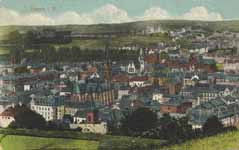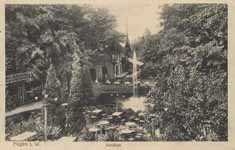.



4, 5, 6,
7, 8, 9, 10, 11,
Hagen
Hagen is the 39th-largest city in Germany, located in the federal state of North Rhine-Westphalia. It is located on the eastern edge of the Ruhr area, 15 km south of Dortmund, where the rivers Lenne, Volme and Ennepe meet the river Ruhr. As of 31 December 2010 the population was 188,529. The city is home to the FernUniversität Hagen, which is the only state funded distance education university in Germany. Counting more than 67,000 students (March 2010), it is the largest university in Germany. [1]
History
Hengsteysee
Hagen was first mentioned ca. 1200, presumably the name of a farm at the junction of the Volme and the Ennepe. After the conquest of Burg Volmarstein in 1324, Hagen passed to the County of Mark. In 1614 it was awarded to the Margraviate of Brandenburg according to the Treaty of Xanten. In 1701 it became part of the Kingdom of Prussia.
After the defeat of Prussia in the Fourth Coalition, Hagen was incorporated into the Grand Duchy of Berg from 1807–13. In 1815 it became part of the new Prussian Province of Westphalia.
The growth of the city began in the 19th century with the mining of coal and the production of steel in the Ruhr Area. It was the scene of fighting during the Ruhr Uprising, 13 March - 2 April 1920 and has a monument to the Ruhr Red Army.
In 1928 Hagen developed into a city of more than 100,000 inhabitants.
On the night of 1 October 1943, 243 Lancasters and 8 Mosquitos from the Royal Air Force's Bomber Command attacked the city. According to the Bomber Command Campaign Diary, "This raid was a complete success achieved on a completely cloud-covered target of small size, with only a moderate bomber effort and at trifling cost." Severe damage was caused.
After World War II the town became part of the new state of North Rhine-Westphalia.
Economy
Owing to the extensive use of water power along the rivers Ruhr, Lenne, Volme and Ennepe, metal processing played an important role in the region of Hagen in and even before the 15th century.
In the 17th and 18th century, textile and steel industries as well as paper production followed.
Hagen is the home of the Suedwestfaelische Industrie- und Handelskammer.
Attractions
Hagen is home to the Westfälisches Freilichtmuseum Hagen, or Hagen Westphalian Open-Air Museum, a collection of historic industrial facilities where trades such as printing, brewing, smithing, milling, and many others are represented not simply as static displays, but as living, working operations that visitors may in some cases even be invited to participate in. It is located in the Hagen community of Eilpe. The Historical Center contains the Museum of the City and the Werdringen castle. In the Blätterhöhle cave in Hagen the oldest fossils of modern people in Westphalia and the Ruhr were found. They are dated to the early Mesolithic, 10,700 years B.C.
Panoramic view of Hagen (taken from urban forest of Hagen)
Boroughs
Half-timbered houses "Lange Riege" (17th century)
Borough Population
Oct 2007 Area
in km²
Hagen-Mitte 78.952 20,5
Hagen-Nord 38.451 29,6
Hagen-Haspe 30.360 22,2
Hagen-Eilpe/Hagen-Dahl 17.148 51,1
Hagen-Hohenlimburg 31.306 37,0
some localities of Hagen:
Hagen-Dahl
Hagen-Emst
Hagen-Priorei
Hagen-Rummenohl
Hagen-Halden
Traffic
Shunting yard Hagen-Vorhalle
The Autobahnen A1, A45 and A46 touch Hagen.
Hagen has been an important rail junction for the southeastern Ruhr valley since the first rail line opened in 1848. The shunting yard of Hagen-Vorhalle is among Germany's largest, and the central station offers connections to the ICE network of Deutsche Bahn as well as to local and S-Bahn services. Since December 2005, Hagen has also been the starting point for a new service into Essen, operated by Abellio Rail.
Local traffic is handled by Hagener Straßenbahn (Hagen Tramways), which, despite its name, offers only bus services, as the last tramway in Hagen went out of service in the 1970s. All local rail and bus services operate under the transport association VRR.
Sport
The German Basketball Federation (DBB) is based in Hagen
Sport clubs in Hagen:
TSV Hagen 1860 - largest club (multiple fistball champions)
SSV Hagen (1974 basketball champions), later known as Brandt Hagen
Phoenix Hagen
Hasper SV
Hohenlimburger SV (multiple women water polo champions)
International relations
Main article: List of twin towns and sister cities in Germany
Hagen is twinned with the following towns:
Poland - Ełk (Poland), since 1955
France - Liévin (France), since 1960
Finland - Kouvola (Finland), since 1963
France - Montluçon (France), since 1965
Germany - Steglitz-Zehlendorf, Berlin (Germany), since 1967
Austria - Bruck an der Mur (Austria), since 1975
Russia - Smolensk (Russia), since 1985
Israel - Modi'in-Maccabim-Re'ut (Israel), since 1997
Personalities
Sir Charles Hallé (Karl Halle) was born here in 1819
Nena (born 24 March 1960 in Hagen), German pop singer
Karl Ernst Osthaus (1874–1921), patron of the avant-garde
Nicholas (Klaus) Rescher (born 15 July 1928) American Philosopher
Mousse T. (born 2 October 1966 in Hagen), German DJ and record producer
Franz Bronstert (1895–1967) painter
Emil Schumacher (1912–1999) painter and co-founder of German abstract art
Henning Wehn (born 10 April 1974 in Hagen), German comedian
Bettina Hauert (born 18 June 1982 in Hagen), German professional golfer
See also
Accumulatoren-Fabrik AFA
Wippermann jr GmbH
References
^ "Amtliche Bevölkerungszahlen" (in German). Landesbetrieb Information und Technik NRW. 31 December 2010.
From Wikipedia, All text is available under the terms of the GNU Free Documentation License
Hellenica World - Scientific Library

